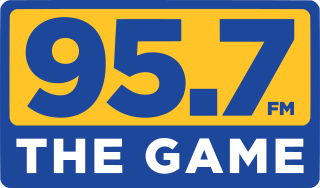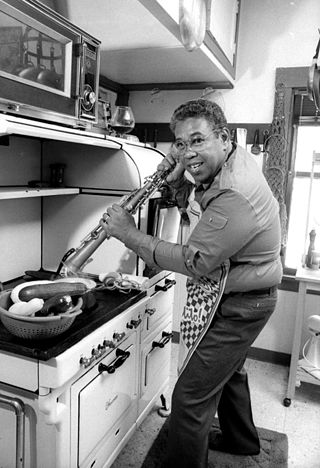KJAZ: Jazz music
Pat Henry ownership
The Federal Communications Commission (FCC) granted a construction permit to Patrick Henry and Dave Larsen on December 10, 1958, for a new radio station to be built on 92.7 MHz in Alameda. Henry was a jazz DJ on Oakland radio station KROW and a recognized leader in the Bay Area jazz community. [2] Larsen, a Minnesota native, [3] was the program manager of KNOB, a jazz radio station in Los Angeles. [4] Henry noted that as larger broadcasters bought previously independent radio operations, he felt that they would no longer broadcast jazz music. [5]
Broadcasting from studios and a transmitter site on Telegraph Avenue in Berkeley as well as secondary studios in Alameda's South Shore Shopping Center, [6] KJAZ debuted on August 1, 1959. [lower-alpha 1] The first song played was a Miles Davis recording of an arrangement by Gil Evans. [10] [lower-alpha 2] It broadcast for 15 hours a day, from 9 a.m. to midnight. [9] Voices heard on the station at launch included S. I. Hayakawa, a semanticist and jazz fan. [13] Larsen sold his interest in KJAZ to Henry in 1960 and joined the staff of San Francisco station KBAY, [14] helping to found a second San Francisco-area jazz outlet, the short-lived KHIP-FM, later that year. [15] The station focused on newer jazz recordings, in part because Henry felt the quality of older recordings was ill-suited for the "high-fidelity" FM band. [11]

In November 1962, KJAZ moved its transmitter to the Russian Hill neighborhood of San Francisco, its antenna on top of the tallest apartment building on the hill (21 [16] or 28 [17] stories high). The new facility increased the station's coverage in most areas, though it was lost in some fringe areas such as Monterey. [16] The station was turning a profit by 1965, when it relocated its studios to 1509 1/2 Webster Street in Alameda and began stereo broadcasting. [18] In the Alameda studios, the station would sometimes have to reduce its volume in order to not disturb patients of a nearby dentist's office. [19] By 1972, other stations offered specialty jazz programming, but KJAZ was the Bay Area's only full-time jazz outlet. [20] With its telephone lines from Alameda to San Francisco, it aired live such events as the last performance of the Modern Jazz Quartet and concerts featuring such names as Stanley Turrentine, Morgana King, Horace Silver, and Milt Jackson. [21] As the years progressed, Henry became more vocal about expressing his music taste through the station. He was known to call from his home when the station played a song he felt did not belong. [22]
License challenge
In 1974, the Committee for Open Media (COM)—a group created by a philosophy professor at San Jose State University—filed petitions against the broadcast license renewals of KJAZ and seven other California broadcast stations. [23] COM believed that KJAZ was not adequately serving community needs. Some jazz fans believed that the station's devotion to a music form otherwise scarcely heard on the Bay Area dial countered its lack of public affairs content. In the Berkeley Daily Gazette, for instance, Gordon Laddue highlighted the station's unique programming and noted its full-day tribute to Duke Ellington upon his death earlier that year. [24] At the same time that the COM petition was pending, Henry was trying to counter an increasing reputation by the station for playing "conservative" jazz; he noted that most of the recordings KJAZ aired were from 1968 or later and ascribed the reputation to its extensive specialty programming. [21]
The FCC awarded KJAZ a renewal of its license in 1976, but COM petitioned for FCC reconsideration [25] and a reversal in federal appeals court. [26] The FCC then asked for the case to be remanded to it in order to resolve factual conflicts that it believed required a hearing. COM, seeking to foreclose on that possibility, proposed the transfer of KJAZ to a non-profit corporation that would be Black-controlled; this became a moot point when the proceeding was remanded by the court, setting in motion the designation of a hearing. [27] Believing that Henry wanted to sell after the matter was settled, a group known as the San Francisco Bay Area Jazz Foundation formed; notable members included Clint Eastwood and Orrin Keepnews. [28] In early 1978, the FCC held off acting on a staff recommendation that the license be designated for hearing after receiving reports that COM had offered $1 million to buy the station, which would have been seen as an abuse of commission processes; [29] when it vacated its earlier renewal in October 1978, this was designated as an issue in the hearing process. [30] The KJAZ hearing was particularly unusual because of the station's reputation and the fact that, by 1978, Henry had improved the station in response to criticism; George Ross of the Oakland Tribune accused the stakeholders of "loving KJAZ and all that jazz ... loving it perhaps to death". [5]

In early 1979, Henry reached a deal to sell KJAZ in a distress sale to the Mabuhay Corporation for $1.675 million—substantially below market value, as required under the distress sale provisions, which provided for transactions to minority-controlled groups to end hearing matters before the FCC. [31] This would have made it the first Filipino-American–owned station in the continental U.S. [32] Mabuhay's controlling owner was San Francisco doctor Leonilo Malabed, who also had bank and newspaper interests. [33] Mabuhay pledged to keep the jazz format. [31] While the Mabuhay deal was pending, workers who had attempted to unionize KJAZ went on strike in August after Henry fired two employees, with the workers citing "poverty-level wages and stone-age benefits". [34] Henry and family members began operating the station in lieu of the striking workers. [35] COM opposed the Mabuhay transfer at below market value, with Malabed claiming he was not the "right minority" in its eyes. [36]
Largely unheralded at the time, Mabuhay and Malabed had extensive ties to Ferdinand Marcos, a dictator who ruled the Philippines at the time. The Committee on Open Media objected to the sale, relying on reporting by Alex Esclamado, an opponent of Marcos and the publisher of the anti-Marcos newspaper The Philippine News. Article by Esclamado indicated that Mabuhay was a front group for pro-Marcos interests. He cited Mabuhay's connections to the Philippine Bank of California, which had been funded by the Marcos government, as well as Malabed's use of consulate license plates and publication of a pro-Marcos newspaper. [37] The deal fell apart in October 1979, [36] according to Malabed, because it had been advised that the sellers possibly lacked clear title to the business; [38] Henry's attorney, Roger Metzler, noted that the deal had hit a deadline without a final FCC ruling. When Marcos was deposed in February 1986, he fled to the United States, where officials seized documents that implicated the use of Mabuhay as a funnel for donations to pro-Marcos politicians in the U.S. [39] Mabuhay also provided funding for attempts coordinated by the Philippine government to crush dissident, including the 1981 murders of Seattle cannery workers Silme Domingo and Gene Viernes, who were leading an anti-Marcos effort with their union. [40]
Ron Cowan ownership
In December 1979, Ron Cowan, a real estate developer with projects in Alameda and elsewhere, and Lionel Wilson, the mayor of Oakland, formed KJAZ Inc. to buy the station from Henry. Wilson, who was Black, owned 50 percent of the firm to satisfy the distress sale requirement of a minority-controlled buyer. [41] His ownership of exactly 50 percent caused a delay to the sale after the commission ruled that a majority minority ownership was 50.1 percent or greater, leading the FCC's broadcast bureau to oppose the transaction. [42] [43] During this time, Henry and COM reached a settlement of the original 1974 license challenge, but Pat Henry noted that the stress associated with the station's recently turbulent history left him committed to sell. [44]

Cowan professionalized the formerly mom-and-pop operation, cited by Billboard magazine as "one of the most respected radio stations in the country", [45] with full-time sales representatives to replace the heavy use of barter agreements with advertisers under Henry, [19] back-office procedures, and employee benefits. [46] The music mix was changed to reflect less of Henry's personal taste and give the disc jockeys more freedom on the air. However, the station required more financial subsidy than its buyers had previously estimated. [47] A heavy slate of outside promotion, which Henry shunned, included broadcast advertising [45] and the sponsorship of a San Francisco International KJAZ Festival in 1981. [48]
After 18 months, Cowan sought to sell the station to focus on Harbor Bay Isle, a major master-planned development of his on Bay Farm Island in Alameda, disappointing Wilson; [46] KJAZ never changed hands, and Cowan instead bought Wilson's share in the station. [49] In late 1983, with the station continuing to lose money, [22] Cowan made more major changes, including making the music mix more contemporary and dismissing 22-year station veteran Dick Conte; many believed Conte was dismissed for leading another attempt at unionizing KJAZ. [50] The new format was designed to be more consistent throughout the day; it increased listenership and advertising revenue [22] and cultivated a select, high-income audience. [51]

In 1987, KJAZ moved from its longtime studios in Alameda to a facility in Cowan's Harbor Bay Isle development. The facility featured panoramic views of the area as well as a grand piano for live performances. [52] [51] [19] In May 1988, the station debuted Jazz Over the Pacific, a nightly hour-long show originating from KJAZ and broadcast via satellite to Japan's FM Tokyo; it was the first regularly scheduled live radio show broadcast from the U.S. to Japan. Cowan had been cultivating KJAZ contacts in the country since 1980, when he was part of a California trade delegation to the country. [53]
Despite the station's prosperity in the late 1980s, [51] KJAZ's financial performance worsened in the early 1990s. In part, this was because of the increasing presence of jazz on other local stations, particularly KCSM, a noncommercial station owned by the College of San Mateo, which began broadcasting jazz around the clock, six days a week and had a stronger signal. KJAZ founder Henry was one of its disc jockeys. [54] At one point, KJAZ's general manager suggested the college change music formats to avoid damaging his station. [55] In 1992, Cowan denied rumors that the station was bankrupt, though he admitted that revenues were down, in line with the broadcast industry. [56] The next year, Cowan took out a bank loan to finance a project to turn KJAZ into a satellite-distributed, national service, much as WFMT in Chicago had done with classical music. He called reports of financial difficulties "ridiculous" and noted that he was pressing forward with KJAZ in spite of calls from prospective buyers, eager to add a station in the market after recent relaxation of ownership rules. [57] The satellite service debuted on June 30, 1993, as the National Jazz Radio Network, a joint venture with Oklahoma-based United Video; cable systems in such places as Orlando, Florida; Richmond, Virginia; and Columbus, Ohio, began offering KJAZ's national signal to their subscribers, while its programming was also offered to other radio stations. [58]
As with KJAZ, the early 1990s were a fraught time for Cowan. He spent years wooing the University of California, San Francisco to build a biotechnology park in Harbor Bay Isle and was close with Willie Brown, then in the California State Assembly. [59] University of California president Jack Peltason ordered an investigation into the matter, [60] which centered on Cowan's friendship with UC regent Ronald Brady. [61] UC officials were found to have attended lavish parties thrown by Cowan, in part to woo university projects, while ignoring rules against accepting gifts. [62]
Sale and closure
As early as August 1993, reports had Cowan selling KJAZ itself to a foreign-language broadcaster and buying another station as the base for his jazz programming. [63] In February 1994, Cowan officially put the station—America's lone 24-hour commercial jazz outlet [64] —on the market, unable to afford putting more money into the venture. [65] The national satellite service only aired on seven cable systems and two radio stations. [66]
Cowan asked $7 million for the station, even though one media broker, Elliot Evers, told the San Francisco Chronicle that a fair value for the frequency was $3 million. Evers noted that the station's central coverage area would likely appeal to broadcasters programming in languages other than English, stating, "My guess is KJAZ will go Spanish or Asian." [66] Listeners began organizing in an effort to save KJAZ, raising $250,000 by early May. [67] That month, Cowan agreed to sell the station for $6 million to Z-Spanish Radio Network, owner of stations in Fresno, Sacramento, and Walnut Creek. [68] Meanwhile, the station continued selling memberships in hopes of building up enough money to remain on the air as a jazz outlet, reaching $700,000 by early June [69] and $1 million by the middle of the month—far below the $3 million necessary to prevent the sale to Z-Spanish from going forward. [70] Cowan's financial holdings continued to unravel; his debts exceeded assets by over $10 million, [71] he was found to be in default on more than $6 million in loans, [72] and furniture was seized from his mansion to pay for spousal support payments. [73]
The fundraising drive to save KJAZ fell short, and on June 30, Cowan announced that the station would be taken over by Z-Spanish Radio Network and change formats on August 1, 1994. [71] KJAZ made its final FM broadcast on July 31, 1994, with the final song being "Springsville" by Miles Davis. [74] Cowan restored the KJAZ satellite service in November, [75] but owing to insufficient financial support, it closed in August 1995. [76] The KJAZ music collection was donated to KCSM in late 1998; the 20,000 vinyl records and 10,000 CDs [77] included rare LPs from Pat Henry's private collection. [78]










